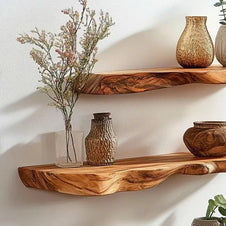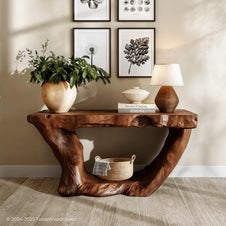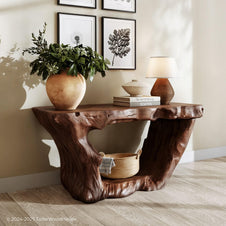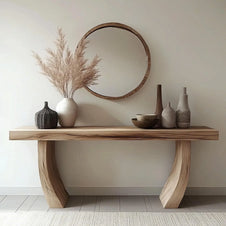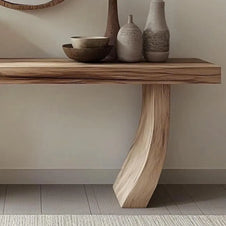Custom tree bookshelves are conversation pieces - but is the beauty worth the price? In this article, we delve into the key pros and cons of the real tree bookshelf that matter most to homeowners seeking style, functionality, and lasting value from a handcrafted furniture piece.
Why Tree Bookshelves Are Popular Yet Pricey
Tree bookshelves bring a sculptural, nature-inspired look to any space, especially small ones. Their biggest pro is space-saving: by going vertical, they free up floor space while adding a decorative touch. They also double as conversation starters, blending form and function in one piece.
However, like all furniture, they come with cons. Most tree bookshelves aren’t built to hold very heavy or oversized books. Their asymmetrical shelves also limit the amount of storage space available. On top of that, higher-end versions may be more expensive than standard shelving.
Still, when comparing tree bookshelf pros and cons, many homeowners find the benefits outweigh the trade-offs. For those who value artistic design and thoughtful craftsmanship, the higher cost is often seen as a long-term investment.

This beech wood tree bookshelf brings a natural, minimalist charm to modern, eco-conscious interiors. Its clean design balances simplicity with visual appeal.
Additionally, tree bookshelf pros and cons depend heavily on your space and usage. If you live in a studio or compact apartment, maximizing vertical storage without sacrificing style is a huge advantage. These bookshelves aren't just functional - they help tell a visual story in your home.
In short, when weighing the tree bookshelf pros and cons, it’s clear that they’re more than just furniture - they're statement pieces that reflect personal taste and creativity.
The Hidden Value Behind the Design
Among the lesser-known pros, a tree bookshelf can be a conversation piece, adding personality to plain corners. It fits well in minimalist or rustic spaces.
However, a possible con is that some designs prioritize looks over capacity. Choose wisely based on your storage needs: a common trade-off noted in the tree bookshelf pros and cons.
1. Space-Saving Without Looking Boring
One of the most compelling advantages of a tree bookshelf is its ability to maximize vertical space without overwhelming a room. Unlike bulky, wide bookshelves, their often slender, upward-reaching designs fit seamlessly into narrower walls or corners.
This is a significant pro in the tree bookshelf pros and cons equation for urban dwellers or those with limited living areas. It’s also worth noting that many homeowners look at tree bookshelf pros and cons not just for space-saving, but also for long-term versatility across different rooms and styles.
2. Aesthetic Impact in Small or Dull Spaces
Tree bookshelves act as a form of architectural art, breathing life and character into otherwise uninspired spaces.
They offer an instant focal point, drawing the eye and adding a layer of sophistication. This aesthetic punch is particularly impactful in rooms that lack inherent architectural interest, making it a strong point among the tree bookshelf pros and cons.
3. Customization That Reflects You

Crafted from solid wood, this upright tree-style bookcase adds artistic flair and sturdy functionality, ideal for those who want storage that stands out.
Many tree bookshelves, especially those from specialized artisans, offer a high degree of customization. This could range from choosing the type of wood and finish to specifying the number and angle of the "branches" to accommodate your book collection.
This level of personalization ensures that your tree bookshelf is not just a piece of furniture, but a reflection of your style and needs.
This bespoke quality is a clear advantage when weighing the tree bookshelf pros and cons, especially for those seeking a blend of practicality and individuality.
The True Cost of Craftsmanship
Delving deeper into the tree bookshelf pros and cons requires an honest look at what goes into their creation and, consequently, their price. It's not just about the raw materials; it's a combination of factors that contribute to the final investment.
1. Not Just About the Price Tag
When you see a high price on a tree bookshelf, it's easy to assume it's solely for the "look." However, the cost encompasses more than just aesthetics. It reflects:
|
Factor
|
Detailed Explanation
|
|
Design Complexity
|
- Organic, asymmetrical forms require high-level design skills.
- Often involves CAD modeling or custom templates.
- Must balance aesthetics with structural integrity.
|
|
Labor Intensive
|
- Each "branch" is individually cut, shaped, sanded, and finished by hand.
- Far more time-consuming than mass-produced shelves.
- Requires skilled craftsmanship.
|
|
Specialized Tools
|
- May require CNC routers, custom jigs, or unique clamps.
- Tools and processes go beyond standard furniture-making.
- Adds to overall production cost.
|
Considering these elements helps contextualize the initial sticker shock, providing a fuller picture of the tree bookshelf pros and cons from an investment perspective.
2. Materials: Solid Wood vs Engineered

Perfect for corners, this handcrafted real wood bookshelf makes smart use of underutilized space while adding a rustic, organic touch to the room.
The choice of material significantly impacts both the cost and the longevity of a tree bookshelf.
|
Material Type
|
Pros
|
Cons
|
|
Solid Wood
|
- Durable and long-lasting
- Can be sanded and re-stained to refresh its appearance
- Showcases a warm, organic look with one-of-a-kind wood grain details
- A more eco-friendly choice when ethically harvested
- Tends to be weighty, which can make rearranging challenging
|
- Higher upfront cost
- Heavier, making it harder to move
- Susceptible to humidity changes (expansion/contraction)
- Can be scratched or dented more easily than some finishes
|
|
Engineered Wood (MDF, Plywood)
|
- More affordable
- Lightweight build makes it simple to relocate
- Consistent finish and color
- More resistant to moisture-related warping
- Good for intricate cuts due to uniform density
|
- Prone to quicker deterioration with regular use
- Offers limited options for repair or restoration
- Potentially emits indoor air pollutants like VOCs
- Has a shorter usable life compared to hardwood alternatives
- Less natural aesthetic; often requires veneers
|
According to Kreg Tool’s woodworking guide, engineered wood like MDF is lighter and more affordable but may not last as long as solid oak or walnut. For a tree bookshelf that endures, hardwood is a smart, long-term choice.
While engineered options might seem appealing due to lower upfront costs, the long-term tree bookshelf pros and cons lean towards solid wood for durability and lasting value.
3. Time, Shipping, and Assembly: What You Might Overlook
When weighing tree bookshelf pros and cons, many people focus solely on design and price, yet logistical factors can be just as impactful.
-
Lead Time: Most tree bookshelves are handcrafted or made to order, meaning you could wait several weeks or even months for delivery. This extended timeline reflects the artisan’s focus on quality and precision, but it’s a drawback if you’re seeking an immediate solution.
-
Shipping Costs: Their irregular shapes and solid wood construction make these bookshelves bulky and expensive to ship. Protective packaging and specialized handling (like white-glove delivery) add to the total price tag.
-
Assembly Requirements: Larger models often require detailed, time-consuming assembly. The branch-like structure demands a precise fit and may call for professional installation if tools or experience are lacking.
These often-overlooked factors are a key part of the broader tree bookshelf pros and cons, especially for those on a tight timeline or budget.
What Buyers Often Regret
Despite their visual charm, tree bookshelves aren’t always a perfect fit for every buyer. Understanding some key tree bookshelf pros and cons can save you from regret and help you make a smarter purchase.
1. Underestimating Assembly Time
One of the most common buyer regrets is underestimating how long it takes to assemble these bookshelves.
-
Intricate Parts: Unlike basic shelving units, tree bookshelves often have oddly shaped “branches” that require careful positioning.
-
Vague Instructions: Some kits come with poorly illustrated manuals, making the process confusing.
-
Need for Two People: Many models need two people for proper assembly, especially for stability.
How to Avoid It: Read buyer reviews that mention assembly. Watch online tutorials and prepare all tools in advance. If DIY isn’t your strength, hiring someone might be worth it. With the right preparation, one of the biggest cons becomes manageable.
2. Expecting Too Much Storage
One major downside on the list of tree bookshelf pros and cons is limited storage. Many buyers mistakenly assume the shelves can hold large or numerous books.
In reality, the shallow “branches” are mostly suited for paperbacks or décor items, not bulky textbooks or heavy binders.
How to Avoid It: Measure your books and compare them to shelf dimensions. Consider what you’ll store long term. These shelves are ideal for light displays, not serious storage.
3. Choosing the Wrong Size or Model
Some buyers pick a shelf based on looks alone, ignoring scale and space.
-
Too Big: A large shelf may crowd a small room and block natural light.
-
Too Small: A compact unit might look awkward in a spacious area.
-
Stability Risks: Designs with narrow bases may tip over easily, especially around children or pets.
How to Avoid It: Use painter’s tape to map out dimensions. Consider both aesthetics and practicality. Anchoring the shelf to the wall improves safety. This is one of the less obvious yet important tree bookshelf pros and cons that people tend to overlook.

This wall-mounted tree bookshelf saves floor space while doubling as a decorative statement. A stylish and practical solution for compact living areas.
FAQs
-
Are tree bookshelves space-saving?
Yes, they take advantage of vertical space, making them ideal for small apartments. In fact, among the most notable tree bookshelf pros and cons, this space-saving quality is often cited as a top benefit.
-
Are they easy to install?
Most are. Look for freestanding models or ones with mounting kits. Some buyers consider ease of setup an important factor when evaluating tree bookshelf pros and cons.
-
What are the key pros and cons?
Pros: Compact, eye-catching, versatile.
Cons: Limited shelf depth, may not suit heavy book collectors.
Conclusion
Ultimately, choosing a tree bookshelf comes down to your space, taste, and priorities. While they may come with a slightly higher price tag, their artistic design, vertical efficiency, and customizable features make them stand out.
If you’re someone who values both function and aesthetics, this piece can easily become a highlight in your home. When considering tree bookshelf pros and cons, the balance often favors its unique value.
Explore handcrafted options from Tailor Wood Haven to find one that suits your style.


